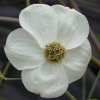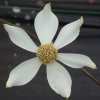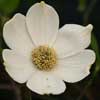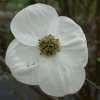|
|
|
 |
CORNUS
'Ascona ' (C. florida x C. nuttallii) A small tree with gently pendulous branches. Thus it becomes clothed down to the ground with large white bracts in April. Vivid red autumn colour. |
|
|
|
| CORNUS nuttallii
'Colrigo Giant' This vigorous American form was named after the Columbia River Gorge in which it was discovered. It is a magnificent small tree of upright habit with enormous flower heads up to 15cm across in April. |
|
|
|
|
| CORNUS nuttallii
'Monarch' A selected form of broader habit, with large rounded flower bracts and purplish young shoots. Stunning bright red autumn colour. |
|
|
|
|
 |
CORNUS nuttallii
'North Star' A statuesque form of upright habit with incredibly large flower bracts and dark purple young shoots. It frequently produces a second flush of flowers in the autumn. Lovely autumn colour. The bracts do not expand to overlap, giving a star like effect. |
|
|
|
 |
CORNUS nuttallii
'Portlemouth' This first occurred in a garden near Salcombe, Devon. It has large flower bracts in April and often again in the autumn, along with good autumn colours, but we find it to be a stout shrubby plant and not a particularly good doer. As a result it is something that we maintain in the collection, but rarely propagate. |
|
|
|
| CORNUS
nuttallii 'Zurico' A recent selection, expressing the typical characteristics of this dramatic species at their very best. See it in our Woodland Walk. |
|
|
|
|
 |
CORNUS
'Ormonde' (C. florida x C. nuttallii) A handsome broad small tree with the requisite large flower bracts. Superb autumn colour. |
|
|
|
| CORNUS
officinalis 'Spring Glow' Previously attributed to Cornus mas, this splendid cultivar is actually a selection of C. officinalis. The most useful visual difference is that C. officinalis with maturity develops attractive exfoliating bark. The late J. C. Raulston introduced this one. As a species, this group flowers best after a cold winter, but this one requires less cold, so is great in warmer climes. See it in our Winter Garden. |
|
|
|
|
| CORNUS
'Pink
Blush' (C. nuttallii x C. florida var. rubra) This is a fantastic American hybrid Dogwood. As it is of the same parentage, it could be described as a pink-flowered C. 'Eddies White Wonder', but that might be stretching the point a little! It rapidly forms a symmetrical small tree and produces masses of large pink-flushed flower bracts in June, darkening with age. Fabulous autumn colours too. This is a personal favourite of mine. It provides seasonally spectacular multi-season interest and I love its symmetrical habit. See it in our Woodland Walk. |
|
|
|
|
| CORNUS
'Porlock' (C. capitata x C. kousa) A sister seedling originally to the popular Cornus 'Norman Hadden', 'Porlock' is semi-evergreen dependant on the weather and location, though often less evergreen than C. 'Norman Hadden'. (Consider it to be one step closer to its kousa parentage.) Like its sibling, it bracts later in the summer, being at its best from June into July, or even later. The bracts open creamy white and mature to pink, going through a wonderful almost apricot phase. See it in our Gardens. |
|